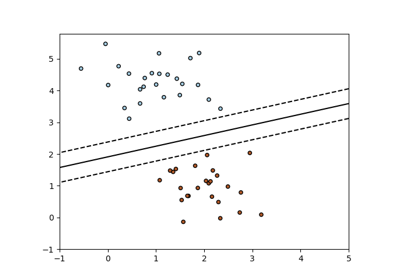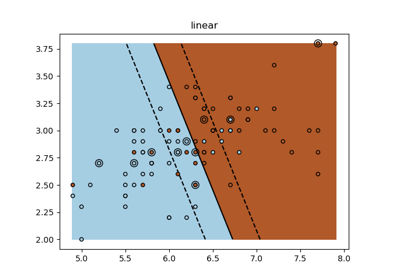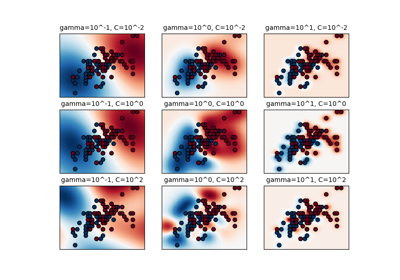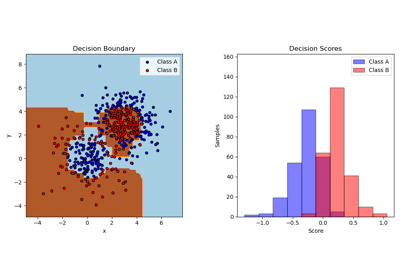Note
Go to the end to download the full example code or to run this example in your browser via JupyterLite or Binder
Libsvm GUI¶
A simple graphical frontend for Libsvm mainly intended for didactic purposes. You can create data points by point and click and visualize the decision region induced by different kernels and parameter settings.
To create positive examples click the left mouse button; to create negative examples click the right button.
If all examples are from the same class, it uses a one-class SVM.
# Author: Peter Prettenhoer <peter.prettenhofer@gmail.com>
#
# License: BSD 3 clause
import matplotlib
matplotlib.use("TkAgg")
from matplotlib.backends.backend_tkagg import FigureCanvasTkAgg
try:
from matplotlib.backends.backend_tkagg import NavigationToolbar2Tk
except ImportError:
# NavigationToolbar2TkAgg was deprecated in matplotlib 2.2
from matplotlib.backends.backend_tkagg import (
NavigationToolbar2TkAgg as NavigationToolbar2Tk,
)
import sys
import tkinter as Tk
import numpy as np
from matplotlib.contour import ContourSet
from matplotlib.figure import Figure
from sklearn import svm
from sklearn.datasets import dump_svmlight_file
y_min, y_max = -50, 50
x_min, x_max = -50, 50
class Model:
"""The Model which hold the data. It implements the
observable in the observer pattern and notifies the
registered observers on change event.
"""
def __init__(self):
self.observers = []
self.surface = None
self.data = []
self.cls = None
self.surface_type = 0
def changed(self, event):
"""Notify the observers."""
for observer in self.observers:
observer.update(event, self)
def add_observer(self, observer):
"""Register an observer."""
self.observers.append(observer)
def set_surface(self, surface):
self.surface = surface
def dump_svmlight_file(self, file):
data = np.array(self.data)
X = data[:, 0:2]
y = data[:, 2]
dump_svmlight_file(X, y, file)
class Controller:
def __init__(self, model):
self.model = model
self.kernel = Tk.IntVar()
self.surface_type = Tk.IntVar()
# Whether or not a model has been fitted
self.fitted = False
def fit(self):
print("fit the model")
train = np.array(self.model.data)
X = train[:, 0:2]
y = train[:, 2]
C = float(self.complexity.get())
gamma = float(self.gamma.get())
coef0 = float(self.coef0.get())
degree = int(self.degree.get())
kernel_map = {0: "linear", 1: "rbf", 2: "poly"}
if len(np.unique(y)) == 1:
clf = svm.OneClassSVM(
kernel=kernel_map[self.kernel.get()],
gamma=gamma,
coef0=coef0,
degree=degree,
)
clf.fit(X)
else:
clf = svm.SVC(
kernel=kernel_map[self.kernel.get()],
C=C,
gamma=gamma,
coef0=coef0,
degree=degree,
)
clf.fit(X, y)
if hasattr(clf, "score"):
print("Accuracy:", clf.score(X, y) * 100)
X1, X2, Z = self.decision_surface(clf)
self.model.clf = clf
self.model.set_surface((X1, X2, Z))
self.model.surface_type = self.surface_type.get()
self.fitted = True
self.model.changed("surface")
def decision_surface(self, cls):
delta = 1
x = np.arange(x_min, x_max + delta, delta)
y = np.arange(y_min, y_max + delta, delta)
X1, X2 = np.meshgrid(x, y)
Z = cls.decision_function(np.c_[X1.ravel(), X2.ravel()])
Z = Z.reshape(X1.shape)
return X1, X2, Z
def clear_data(self):
self.model.data = []
self.fitted = False
self.model.changed("clear")
def add_example(self, x, y, label):
self.model.data.append((x, y, label))
self.model.changed("example_added")
# update decision surface if already fitted.
self.refit()
def refit(self):
"""Refit the model if already fitted."""
if self.fitted:
self.fit()
class View:
"""Test docstring."""
def __init__(self, root, controller):
f = Figure()
ax = f.add_subplot(111)
ax.set_xticks([])
ax.set_yticks([])
ax.set_xlim((x_min, x_max))
ax.set_ylim((y_min, y_max))
canvas = FigureCanvasTkAgg(f, master=root)
try:
canvas.draw()
except AttributeError:
# support for matplotlib (1.*)
canvas.show()
canvas.get_tk_widget().pack(side=Tk.TOP, fill=Tk.BOTH, expand=1)
canvas._tkcanvas.pack(side=Tk.TOP, fill=Tk.BOTH, expand=1)
canvas.mpl_connect("button_press_event", self.onclick)
toolbar = NavigationToolbar2Tk(canvas, root)
toolbar.update()
self.controllbar = ControllBar(root, controller)
self.f = f
self.ax = ax
self.canvas = canvas
self.controller = controller
self.contours = []
self.c_labels = None
self.plot_kernels()
def plot_kernels(self):
self.ax.text(-50, -60, "Linear: $u^T v$")
self.ax.text(-20, -60, r"RBF: $\exp (-\gamma \| u-v \|^2)$")
self.ax.text(10, -60, r"Poly: $(\gamma \, u^T v + r)^d$")
def onclick(self, event):
if event.xdata and event.ydata:
if event.button == 1:
self.controller.add_example(event.xdata, event.ydata, 1)
elif event.button == 3:
self.controller.add_example(event.xdata, event.ydata, -1)
def update_example(self, model, idx):
x, y, l = model.data[idx]
if l == 1:
color = "w"
elif l == -1:
color = "k"
self.ax.plot([x], [y], "%so" % color, scalex=0.0, scaley=0.0)
def update(self, event, model):
if event == "examples_loaded":
for i in range(len(model.data)):
self.update_example(model, i)
if event == "example_added":
self.update_example(model, -1)
if event == "clear":
self.ax.clear()
self.ax.set_xticks([])
self.ax.set_yticks([])
self.contours = []
self.c_labels = None
self.plot_kernels()
if event == "surface":
self.remove_surface()
self.plot_support_vectors(model.clf.support_vectors_)
self.plot_decision_surface(model.surface, model.surface_type)
self.canvas.draw()
def remove_surface(self):
"""Remove old decision surface."""
if len(self.contours) > 0:
for contour in self.contours:
if isinstance(contour, ContourSet):
for lineset in contour.collections:
lineset.remove()
else:
contour.remove()
self.contours = []
def plot_support_vectors(self, support_vectors):
"""Plot the support vectors by placing circles over the
corresponding data points and adds the circle collection
to the contours list."""
cs = self.ax.scatter(
support_vectors[:, 0],
support_vectors[:, 1],
s=80,
edgecolors="k",
facecolors="none",
)
self.contours.append(cs)
def plot_decision_surface(self, surface, type):
X1, X2, Z = surface
if type == 0:
levels = [-1.0, 0.0, 1.0]
linestyles = ["dashed", "solid", "dashed"]
colors = "k"
self.contours.append(
self.ax.contour(X1, X2, Z, levels, colors=colors, linestyles=linestyles)
)
elif type == 1:
self.contours.append(
self.ax.contourf(
X1, X2, Z, 10, cmap=matplotlib.cm.bone, origin="lower", alpha=0.85
)
)
self.contours.append(
self.ax.contour(X1, X2, Z, [0.0], colors="k", linestyles=["solid"])
)
else:
raise ValueError("surface type unknown")
class ControllBar:
def __init__(self, root, controller):
fm = Tk.Frame(root)
kernel_group = Tk.Frame(fm)
Tk.Radiobutton(
kernel_group,
text="Linear",
variable=controller.kernel,
value=0,
command=controller.refit,
).pack(anchor=Tk.W)
Tk.Radiobutton(
kernel_group,
text="RBF",
variable=controller.kernel,
value=1,
command=controller.refit,
).pack(anchor=Tk.W)
Tk.Radiobutton(
kernel_group,
text="Poly",
variable=controller.kernel,
value=2,
command=controller.refit,
).pack(anchor=Tk.W)
kernel_group.pack(side=Tk.LEFT)
valbox = Tk.Frame(fm)
controller.complexity = Tk.StringVar()
controller.complexity.set("1.0")
c = Tk.Frame(valbox)
Tk.Label(c, text="C:", anchor="e", width=7).pack(side=Tk.LEFT)
Tk.Entry(c, width=6, textvariable=controller.complexity).pack(side=Tk.LEFT)
c.pack()
controller.gamma = Tk.StringVar()
controller.gamma.set("0.01")
g = Tk.Frame(valbox)
Tk.Label(g, text="gamma:", anchor="e", width=7).pack(side=Tk.LEFT)
Tk.Entry(g, width=6, textvariable=controller.gamma).pack(side=Tk.LEFT)
g.pack()
controller.degree = Tk.StringVar()
controller.degree.set("3")
d = Tk.Frame(valbox)
Tk.Label(d, text="degree:", anchor="e", width=7).pack(side=Tk.LEFT)
Tk.Entry(d, width=6, textvariable=controller.degree).pack(side=Tk.LEFT)
d.pack()
controller.coef0 = Tk.StringVar()
controller.coef0.set("0")
r = Tk.Frame(valbox)
Tk.Label(r, text="coef0:", anchor="e", width=7).pack(side=Tk.LEFT)
Tk.Entry(r, width=6, textvariable=controller.coef0).pack(side=Tk.LEFT)
r.pack()
valbox.pack(side=Tk.LEFT)
cmap_group = Tk.Frame(fm)
Tk.Radiobutton(
cmap_group,
text="Hyperplanes",
variable=controller.surface_type,
value=0,
command=controller.refit,
).pack(anchor=Tk.W)
Tk.Radiobutton(
cmap_group,
text="Surface",
variable=controller.surface_type,
value=1,
command=controller.refit,
).pack(anchor=Tk.W)
cmap_group.pack(side=Tk.LEFT)
train_button = Tk.Button(fm, text="Fit", width=5, command=controller.fit)
train_button.pack()
fm.pack(side=Tk.LEFT)
Tk.Button(fm, text="Clear", width=5, command=controller.clear_data).pack(
side=Tk.LEFT
)
def get_parser():
from optparse import OptionParser
op = OptionParser()
op.add_option(
"--output",
action="store",
type="str",
dest="output",
help="Path where to dump data.",
)
return op
def main(argv):
op = get_parser()
opts, args = op.parse_args(argv[1:])
root = Tk.Tk()
model = Model()
controller = Controller(model)
root.wm_title("Scikit-learn Libsvm GUI")
view = View(root, controller)
model.add_observer(view)
Tk.mainloop()
if opts.output:
model.dump_svmlight_file(opts.output)
if __name__ == "__main__":
main(sys.argv)
Related examples
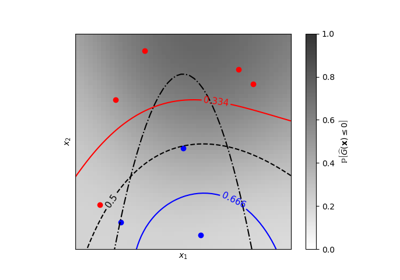
Iso-probability lines for Gaussian Processes classification (GPC)
Iso-probability lines for Gaussian Processes classification (GPC)
